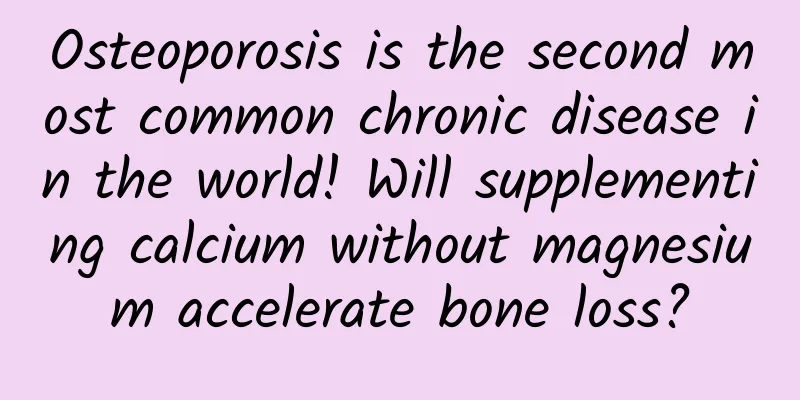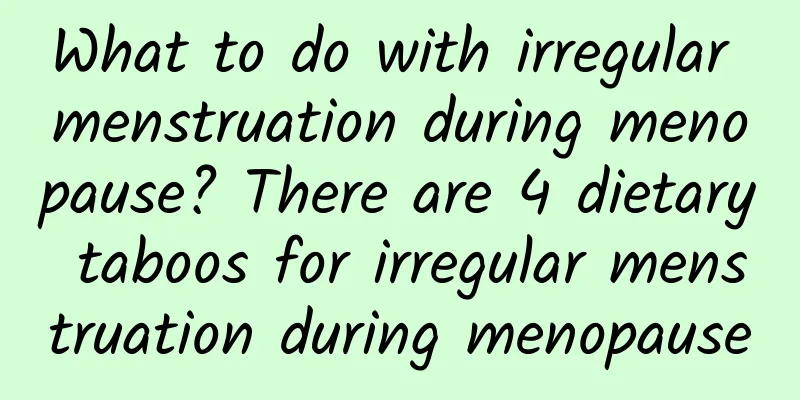Osteoporosis is the second most common chronic disease in the world! Will supplementing calcium without magnesium accelerate bone loss?

|
Osteoporosis (abbreviated as osteoporosis) has become the second largest chronic disease in the world. Osteoporosis can be said to be a silent killer. Early osteoporosis often has no signs, and once bone is lost, it is difficult to recover. If you wait until you have a fracture to seek medical treatment before you want to nourish your bones, it is often too late. Therefore, it is particularly important to strengthen your bones while you are young. However, there is a saying circulating on the Internet: "Supplementing calcium without magnesium will accelerate bone loss." Let's find out how to properly supplement calcium. Nutritionist Chen Yichun will explain it to you. Early osteoporosis is asymptomatic and is usually not discovered until fractures are seen by a doctor.Generally speaking, there are two types of cells in bones: osteoblasts and osteoclasts. When we are young, the rate at which osteoblasts build bones is faster than the rate at which osteoclasts erode bones, so the total amount of bone mass and bone density will continue to increase. However, after the age of 35, bone loss becomes faster than bone production, causing bone density to gradually decrease. This normal decrease in bone mass is called "osteopenia." If the rate of bone loss is too fast, the originally dense bones gradually become thinner, making the bones hollow and loose, becoming fragile and brittle, which is what we often hear about as "osteoporosis". The scary thing about osteoporosis is that it is a silent disease that usually has no symptoms in the early stages. If you don’t have regular health checks, you often don’t realize you have osteoporosis until you seek medical treatment for a fracture caused by an accident. Supplementing calcium without vitamin D and magnesium can still lead to osteoporosis riskOsteoporosis usually occurs in the elderly over 65 years old, especially in women after menopause. Because the estrogen in the body decreases rapidly and there is not enough estrogen to restrain the activity of "osteoblasts", the rate of bone loss is faster than that of ordinary people, so they are prone to "postmenopausal osteoporosis". Once bone mass is lost, it is difficult to fully restore it, so it is particularly important to build strong bones early in life and create a good foundation for the bones. Nutritionist Chen Yichun pointed out that if you want to strengthen your bones, everyone knows that you need to supplement calcium. However, after taking an appropriate amount of calcium, if you do not supplement nutrients such as vitamin D and magnesium, and exercise moderately, you may still be at risk of osteoporosis. This is the right way to strengthen bones: take 3 nutrients togetherHowever, if you want to turn the crisis into an opportunity and make your bones as tough as your will, the following nutritionist Chen Yichun will explain to you the importance of vitamin D and magnesium in strengthening bones, how much you should supplement every day, and what foods you can get from. Bone Care Nutrients 1: Calcium Calcium is the most abundant mineral in the human body and is especially important for strengthening bones. In addition, calcium is also an essential nutrient for maintaining the normal function of the heart, muscles, and nerves, as well as blood coagulation. If the daily dietary calcium intake is insufficient, the body will remove calcium from the bones, causing accelerated bone loss. The Ministry of Health and Welfare recommends that the average adult's daily calcium intake is 1,000 mg. Dairy products are the richest source of calcium in our daily diet. If people are lactose intolerant to drinking milk, they can eat yogurt and yogurt instead. In addition to dairy products, foods such as dried fish, day lily, traditional tofu, and amaranth are also good sources of intake. Bone Care Nutrients 2/Vitamin D The calcium that enters the body through the mouth needs to be absorbed by the gastrointestinal tract before it can actually reach the blood and bones. If calcium is likened to a brick, then vitamin D is like a bricklayer who builds a house, responsible for absorbing calcium into the blood circulation in the small intestine. In addition, vitamin D promotes the reabsorption of ions by the kidneys and reduces the loss of calcium ions in the urine. According to the Ministry of Health and Welfare's "Dietary Reference Intakes for Taiwanese", the recommended intake for people aged 1 to 50 is 5 micrograms (200 international units), while for children under 1 year old and the elderly over 50 years old, the recommended intake is 10 micrograms (400 international units). Generally speaking, the human body can obtain vitamin D from food and sunlight. Foods containing vitamin D include mackerel, salmon, milk, pork liver, etc. However, most of the source of vitamin D for the human body is actually sunlight. The human body can synthesize enough vitamin D on its own by only exposing itself to 10 to 30 minutes of sunlight a day. It is recommended to choose the morning or evening time for sunbathing, but remember not to apply sunscreen or wear sun-protective clothing so that your skin can truly be exposed to the sunlight. Foods containing vitamin D include mackerel, salmon, milk, pork liver, etc. However, most of the body's vitamin D comes from sunlight. Bone Nutrition 3/Magnesium The amount of magnesium stored in the body affects human growth, kidney function, and the metabolic activity of bone cells. Calcium and magnesium are the most important components in bone tissue. The total amount of magnesium in the human body is about 25 to 28 grams, of which the magnesium concentration in bones accounts for about 66% of the total magnesium. If the magnesium concentration in the body is insufficient, it is also related to osteoporosis. If you only take in enough calcium, your bones will be hard but brittle. If you can supplement with an appropriate amount of magnesium, your bones will become hard and tough, and it can also prevent calcium from being lost due to osteoporosis, allowing bones to absorb calcium more efficiently. The Ministry of Health and Welfare recommends that men should consume 380 mg of magnesium per day and women should consume 320 mg. This can generally be obtained from green vegetables, nuts, beans such as peanuts, black beans, soybeans, cashews, and grains such as oats, barley, and wheat. Eat the right nutrition and do weight-bearing exercise to retain calcium in your bonesNutritionist Chen Yichun reminds that after taking in key nutrients, it is also necessary to combine it with "weight-bearing exercise" to increase bone density and retain calcium in the bones. "Weight-bearing exercise" refers to exercise that can apply moderate pressure on the bones, such as skipping rope, marching on the spot, climbing stairs, running, and brisk walking, which are all very good choices. It is advisable to exercise 3 to 5 times a week, each time lasting 30 minutes. The intensity of exercise should be based on the principles of "a little tired but not too tired" and "a little sweaty but not uncomfortable". After taking in the key nutrients, you also need to do weight-bearing exercise to increase bone density and retain calcium in the bones. "Weight-bearing exercise" refers to exercise that can apply moderate pressure on the bones, such as skipping rope, marching on the spot, climbing stairs, running, and brisk walking, which are all very good choices. [Nutritionist's Tips]: It is recommended that women over 60 and men over 65 undergo regular bone density checks. In addition to X-ray measurements of bone density, bone loss can also be checked from the blood and urine. Women can check their bone mass during menopause. If they find that their bone mass is insufficient, they should supplement it as soon as possible. If necessary, they can do a bone density follow-up check a few years later to understand their bone density status. |
Recommend
What are the factors that cause cervical warts
What causes cervical warts in women? As the sayin...
Is fasting blood sugar 9.11 accompanied by irregular menstruation diabetes?
Is fasting blood sugar of 9.11 accompanied by irr...
What are the symptoms caused by vulvar leukoplakia
With the increasing pressure of life and work for...
What are the dangers of acute pelvic inflammatory disease
Acute pelvic inflammatory disease is more common ...
Tell you: Who is not suitable for medical abortion?
Now in our lives, many female friends have unexpe...
TCM's interpretation of Bartholinitis
It is very painful for women to suffer from Barth...
Why is congenital absence of vagina always difficult to cure?
Why is congenital absence of vagina always incura...
3 key points of leg exercises to reduce 5cm in one week
(Author: Lian Shui Hua Yin) The three-point leg p...
What are the ways to prevent cervical erosion?
What should we pay attention to in preventing cer...
Ovarian cysts cause weight gain
Xiaokun is my college classmate. She is very pret...
What is endometrial tuberculosis?
What kind of disease is endometrial tuberculosis?...
Causes of irregular menstruation
Irregular menstruation is also called menstrual d...
Can't stop talking? 10 Tips to Control Your Appetite
When it comes to diet, crazy weight loss or overe...
What symptoms will patients with vulvar leukoplakia experience? Patients with vulvar leukoplakia will always experience vulvar itching
Patients with vulvar leukoplakia always experienc...
Can I clean my vagina a few days after having an abortion?
Abortion usually refers to artificial abortion. I...









